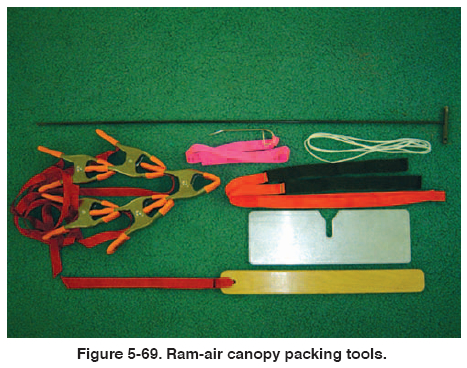Chapter 5
RAM-AIR RESERVE INTO A SPORT PIGGYBACK SYSTEM
In the preceding text, the discussion centered on a parachute
system that was already assembled. This next section
focuses on the assembly of a ram-air parachute
system, the component parts, and the process from the
assembly stage through to packing. While this section
provides guidance and an overview of packing a ram-air
canopy into a sport piggyback system, it is imperative that
the rigger receive proper training from a certificated and
properly rated rigger who has been trained to pack ramair
reserves. 14 CFR, subsection 65.129(f) states, “No
certificated parachute rigger may exercise the privileges
of his certificate and type rating unless he understands the
current manufacturer’s instructions for the operation
involved...”
The following procedure is typical of many current 1-pin
container systems. While this configuration comprises the
majority of those manufactured today, there are other
designs still in use that require different techniques. The rigger must become thoroughly familiar with the other
configurations before attempting to assemble and pack
these systems.
ASSEMBLING THE RESERVE SYSTEM
The following components are necessary to assemble the
harness and container to the ram-air reserve:
1. The harness, container, and associated parts to include
the reserve pilot chute and free bag, reserve ripcord,
reserve steering toggles, reserve closing loop, and
RSL, if desired.
2. Reserve canopy.
3. AAD, if desired.
Before progressing, the necessary tools must be available.
The packing manual should include a recommended tools
list. However, based on the rigger’s experience and packing
technique, the numbers and types of tools needed to
pack this system may vary. Figure 5-69 shows the tools
needed to pack the following ram-air parachute assembly
using the technique described.

COUNT YOUR TOOLS BEFORE BEGINNING!
Begin the assembly procedure in the following manner:
1. Connect the canopy to the risers of the harness, ensuring
line continuity is correct.
2. Tighten the connector links and seal with a telltale
mark.
3. If used, install and secure the connector link bumpers
per the canopy manufacturer’s instructions.
4. Route the control lines through the slider grommets
and guide rings on the rear of the riser. Fasten the
steering toggles in the required manner. [Figure 5-70]

5. Install the AAD, if desired, according to the manufacturer’s
instructions.
6. Install a closing loop of the correct type and length.
7. Attach the reserve free bag to the reserve pilot chute.
The steps for packing this type of parachute are broken
down into the following:
1. Layout, and setting up packing clamps.
2. Stacking and pleating the reserve canopy.
3. Setting the deployment brakes.
4. Folding the canopy.
5. Placing the canopy into the deployment bag, and stowing
the lines.
6. Placing the bag into the container and closing the container.
| 
